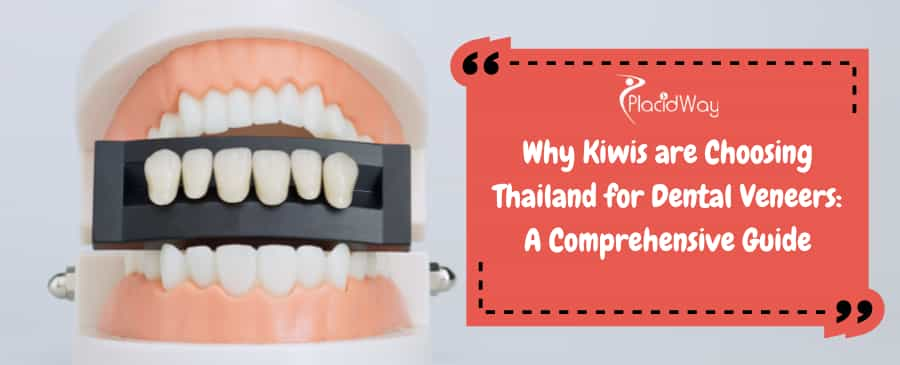
Key Takeaways
- New Zealanders can save 60-80% on dental veneers by traveling to Thailand compared to local prices, with savings often exceeding the cost of the trip.
- Top Thai dental clinics are often JCI (Joint Commission International) accredited, feature internationally-trained dentists, and use the same high-end technology (like CAD/CAM and E-Max veneers) as clinics in New Zealand.
- Porcelain veneers in Thailand cost approximately $400 - $900 NZD per tooth, versus $1,800 - $3,500 NZD in New Zealand.
- A complete smile makeover package (8-10 veneers) in Thailand can range from $4,000 - $8,000 NZD, while the same procedure could cost over $20,000 NZD at home.
Why is Thailand a Top Choice for Kiwi Dental Tourists?
Kiwis are flocking to Thailand for dental veneers due to a powerful combination of massive cost savings, access to world-class, internationally accredited clinics, and the unique opportunity to combine their treatment with a relaxing tropical holiday.
The "Land of Smiles" is no longer just a vacation hotspot; it's a global hub for medical tourism, and dental care is leading the charge. For New Zealanders facing some of the highest dental costs in the world, Thailand presents an almost unbeatable value proposition.
The three main drivers are:
- Massive Cost Savings: The most significant factor. Even after factoring in flights from Auckland or Christchurch and accommodation, the total cost for a full set of veneers can be a fraction of what one would pay in New Zealand.
- World-Class Quality: This isn't about "cheap" dentistry. Top-tier Thai clinics in Bangkok, Phuket, and Chiang Mai are state-of-the-art facilities, often holding JCI accreditation—the same gold standard as top US and European hospitals. Many dentists are trained in the US, UK, or Australia, bringing global expertise.
- The "Dental Holiday": The concept is simple. Why recover in your own home when you can do so by a pool in Phuket? Patients can undergo their initial procedure and then relax, and sightsee while their custom veneers are fabricated, turning a medical trip into a genuine vacation.
Understanding Dental Veneers: What Are They?
Dental veneers are thin, custom-made shells, typically crafted from porcelain or a composite resin, that are bonded to the front surface of your teeth. They are a cosmetic solution designed to fix a wide range of aesthetic issues, from stains and chips to gaps and misalignment.
Veneers are the secret behind many "Hollywood smiles" and are a go-to procedure in cosmetic dentistry. They can permanently correct:
-
Stubborn Discoloration: Stains from coffee, tea, or tetracycline that teeth whitening can't fix.
-
Physical Imperfections: Chipped teeth, broken, or worn-down teeth.
-
Gaps and Spacing: Closing small gaps (diastemas) between teeth.
-
Misalignment: Creating the appearance of perfectly straight teeth without years of orthodontics.
Types of Dental Veneers Available in Thailand
Thai dental clinics offer all modern veneer types, including highly durable Porcelain (like E-Max and Zirconia) and more affordable Composite Resin options. This allows your dentist to tailor the treatment to your budget and aesthetic goals.
-
Porcelain Veneers: This is the premium option. They are exceptionally durable, lasting 10-15 years or more with good care. Their translucent quality mimics natural tooth enamel perfectly, and they are highly stain-resistant. Brands like E-Max and Zirconia are popular for their superior strength and aesthetics.
-
Composite Resin Veneers: This is a more affordable, less-invasive alternative. A dentist sculpts the resin material directly onto your tooth in a single visit. While they are a great budget-friendly option and fix minor issues, they have a shorter lifespan (5-7 years) and can be more prone to staining over time.
-
No-Prep Veneers (e.g., Lumineers): These are ultra-thin porcelain veneers that require minimal to no removal of the natural tooth enamel. They are not suitable for everyone but can be a good option for minor shape or color correction.
Did You Know?
Many top Thai dental labs use advanced CAD/CAM (Computer-Aided Design/Computer-Aided Manufacturing) and CEREC technology. This is the same high-tech equipment used in top-tier NZ clinics. It allows dentists to digitally scan your teeth, design your veneers on a computer, and even mill them in an in-house lab, sometimes in a single day.
The Staggering Cost Difference: Thailand vs. New Zealand
The primary driver for Kiwis is cost; a single porcelain veneer in Thailand is often 60-80% cheaper than in New Zealand. For a full smile makeover, the savings can easily pay for the entire trip, including flights and a luxury hotel stay.
This price difference isn't due to lower quality or-sub par materials. It's a direct result of Thailand's lower cost of living, lower overhead and operational costs, and a highly competitive market for dental tourism.
Here is a typical cost comparison. (All prices are estimates in New Zealand Dollars).
|
Procedure |
Average Cost in New Zealand (NZD) |
Average Cost in Thailand (NZD) |
Estimated Savings |
|---|---|---|---|
|
Porcelain Veneer (per tooth) |
$1,800 - $3,500 |
$400 - $900 |
60-80% |
|
Composite Veneer (per tooth) |
$600 - $1,200 |
$150 - $400 |
65-75% |
|
Full "Smile Makeover" (8-10 Porcelain Veneers) |
$14,000 - $30,000+ |
$4,000 - $8,000 |
70-75% |
|
Initial Consultation & 3D Scan |
$150 - $350 |
Often Free |
100% |
The "Dental Holiday": What Your Trip Looks Like
A typical trip for veneers from New Zealand takes approximately 7 to 10 days. This schedule involves two main dental appointments and allows for plenty of time to recover and enjoy a vacation in between.
Here is a step-by-step breakdown of a typical treatment timeline:
-
Step 1: Initial Consultation & Preparation (Day 1-2)
-
You'll meet your dentist (often a prosthodontist, a specialist in this field).
-
This visit involves a comprehensive exam, X-rays, and 3D digital scans.
-
You will collaborate on your smile design, choosing the shape, size, and shade of your new teeth.
-
The dentist then prepares your teeth by gently shaving a very thin layer (0.3-0.5mm) of enamel. This is done under local anesthesia and is not painful.
-
An impression or digital scan is taken, and you are fitted with high-quality temporary veneers.
-
-
Step 2: Lab Fabrication & Your Holiday (Day 3-6)
-
This is your free time. Your custom porcelain veneers are meticulously crafted in a high-tech dental lab.
-
You can recover, relax by the beach, explore temples, or shop. It's advised to avoid very hard or sticky foods with your temporary veneers.
-
-
Step 3: Final Bonding Appointment (Day 7-9)
-
You return to the clinic. Your temporary veneers are removed.
-
The dentist will place each permanent veneer to check for a perfect fit and color match.
-
Once you are 100% happy, the veneers are permanently bonded to your teeth using a powerful adhesive and a special curing light.
-
The dentist makes final adjustments and polishes your new smile.
-
-
Step 4: Final Check-up (Day 10)
-
A brief follow-up appointment is usually scheduled to check your bite and ensure your gums are reacting well. After this, you are clear to fly home with your new, confident smile.
-
How to Choose a Reputable Clinic in Thailand
Choosing the right clinic is the most important step. Kiwis should prioritize clinics with international accreditation (like JCI), check for specialist dentist qualifications, and insist on transparent, English-speaking staff.
Don't just choose the cheapest option. Your smile is an investment. Here is a checklist for vetting clinics:
-
Look for Accreditation: This is non-negotiable. Top clinics will advertise their JCI (Joint Commission International) accreditation or ISO certification. This ensures they adhere to the highest global standards of safety and hygiene.
-
Check Dentist Qualifications: Who will be doing your procedure? You should be treated by a specialist prosthodontist or an aesthetic dentist with extensive experience in veneers. Reputable clinics will list their dentists' credentials and training—many have studied in the US, UK, Australia, or Germany.
-
See "Before & After" Photos: Ask to see a portfolio of their work, specifically for patients from NZ or Australia. This gives you a real-world look at their aesthetic style.
-
Read Recent Patient Reviews: Look for testimonials on independent platforms (like Google Reviews or medical tourism sites) from other Kiwis.
-
Insist on Clear Communication: The clinic must have fluent English-speaking coordinators and dentists. Miscommunication about your desired outcome is a major risk.
-
Get a Transparent, All-Inclusive Quote: Your quote should detail the brand of veneers (e.g., E-Max), the number of teeth, lab fees, dentist fees, and any follow-up care. There should be no hidden charges.
Expert Insight
"The skill of the dentist is far more important than the brand of porcelain used. A good prosthodontist understands the artistry of a smile—how it balances with your facial features, lip line, and even your gender and age. Don't be afraid to ask your dentist why they are recommending a certain shape or shade. It should be a collaborative 'smile design' process."
What Are the Risks? A Realistic Look
While dental tourism in Thailand is generally very safe, risks do exist. These include potential communication barriers, mismatched aesthetic expectations, and the difficulty of receiving follow-up care for complications once you are back in New Zealand.
It's crucial to be aware of the potential downsides:
-
Follow-up & Complications: This is the most significant risk. What if a veneer chips, or you develop extreme sensitivity two months later? Your NZ dentist may be legally (and ethically) hesitant to take on the liability of fixing another dentist's elective work. This could mean paying expensive local fees or, in rare cases, needing another trip to Thailand.
-
Rushed Procedures: Beware of clinics promising a full makeover in 2-3 days. Quality veneer work takes time. The lab needs time to craft the porcelain, and your gums need to settle. A rushed job can lead to a poor fit, 'bulky' looking teeth, or gum inflammation.
-
Mismatched Expectations: What you call a "natural white" and what the dentist understands may be different. This is why clear communication and digital smile mock-ups are so important.
-
Travel Insurance: Standard travel insurance will not cover you for elective cosmetic procedures. If a complication arises, you are paying for it out-of-pocket. You can buy specialist medical tourism insurance, which is highly recommended.
Preparing for Your Trip
Proper preparation involves getting a dental check-up in New Zealand before you leave, sending your records to the Thai clinic for a remote consultation, and clarifying the total cost of your treatment package.
A little planning goes a long way:
-
Get a Local Check-up: Visit your NZ dentist for a full check-up and cleaning. Get any underlying issues, like cavities or gum disease, treated before you go.
-
Send Your Records: Most Thai clinics offer a free online consultation. Send them clear photos of your teeth and smile, along with any recent X-rays.
-
Confirm Your Treatment Plan: Get a detailed, written treatment plan and an all-inclusive quote. Confirm the timeline and the number of visits required.
-
Book Flights & Accommodation: Book flights with a few buffer days. Stay in a comfortable hotel near your clinic, as you may feel tired after your appointments.
-
Plan for Recovery: Pack essentials like over-the-counter pain relief (e.g., paracetamol) and plan to eat soft foods for the first few days after your procedures.
Aftercare: Protecting Your New Smile
Veneers require the same diligent care as your natural teeth. Excellent oral hygiene, including brushing, flossing, and regular check-ups, is essential. You should also avoid biting very hard objects to prevent chipping.
Your veneers are incredibly strong, but they are not indestructible. To ensure they last for 10-15 years or more:
-
Practice Perfect Oral Hygiene: Brush twice a day and floss daily. Veneers can't decay, but the natural tooth underneath and around them can.
-
Avoid Biting Hard Objects: Don't chew ice, bite your fingernails, or use your teeth to open packets.
-
Wear a Night Guard: If you grind your teeth (bruxism), it is essential to get a custom-made night guard to protect your veneers from chipping while you sleep.
-
See a Dentist Regularly: Continue with your 6-monthly check-ups and cleanings when you return to New Zealand. Inform your dentist that you have veneers.
Frequently Asked Questions (FAQs)
How long do porcelain veneers from Thailand last?
With proper care, high-quality porcelain veneers (like E-Max) from a reputable Thai clinic can last 10 to 15 years, and sometimes even longer. Composite veneers have a shorter lifespan of 5-7 years.
Can veneers be done in one day in Thailand?
This is possible with composite veneers, which are sculpted directly onto the tooth. Some clinics with in-house CEREC (CAD/CAM) labs can also make porcelain veneers in a single day, but this is often rushed. A 2-visit process over 7-10 days is standard for the highest quality and best fit.
Is it painful to get dental veneers?
The procedure itself is not painful. The dentist uses a local anesthetic to completely numb the area before preparing the teeth. You may feel some mild sensitivity or soreness in your gums for a few days after, which is easily managed with over-the-counter pain relief.
How many teeth should I get veneers on?
This depends entirely on your smile and goals. A "smile makeover" typically involves 6, 8, or 10 veneers on the upper teeth (the ones that show when you smile). Some people may only need 2 or 4 to correct specific issues. Your dentist will advise you during the smile design consultation.
What happens if a veneer breaks when I'm back in New Zealand?
This is the main risk of dental tourism. You would need to contact your Thai clinic; they may offer to fix it for free, but you would have to pay for the flight back. A local NZ dentist may be able to create a replacement, but it will be at the full New Zealand price and may be difficult to color-match perfectly.
Can I get travel insurance to cover my dental work in Thailand?
Your standard travel insurance policy will not cover elective cosmetic dentistry or any complications from it. You must purchase a specialized medical tourism insurance policy, which is designed to cover these specific risks.
Start Your Journey with PlacidWay
Ready to explore your options for a life-changing smile? The cost-saving and quality in Thailand are undeniable, but navigating the options to find a trusted, high-quality provider can be overwhelming. PlacidWay, a global leader in medical tourism, is here to guide you.
We take the guesswork and risk out of the process, connecting you with a network of pre-vetted, elite dental partners.
-
Compare Top Clinics: Get free, no-obligation quotes from JCI-accredited and internationally-recognized dental clinics in Bangkok, Phuket, and Chiang Mai.
-
Verify Your Dentist: We help you review the qualifications, experience, and patient testimonials of the specialists who will perform your treatment.
-
Find All-Inclusive Packages: We can help you find comprehensive packages that bundle your smile makeover, accommodation, and private airport transfers for one transparent price.
Don't leave your smile to chance. Contact PlacidWay today for a personalized consultation, and take the first safe, confident step towards the affordable, brilliant smile you deserve.

.png)



-Per-Jaw-Package-in-South-Korea-by-Seoul-Today.png)

.png)
.png)
.png)






Share this listing